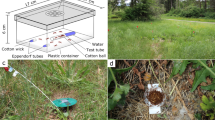Abstract
It has been shown previously that sulfur volatiles produced byAllium plants affect the behavior of their specialist phytophages and of their specialist entomophages. The action of these compounds in protecting the leek mothAcrolepiopsis assectella against generalist entomophages was studied in comparison to the proposed original defensive role of these compounds against generalist herbivorous insects. Two ants species,Formica selysi andF. fusca, were used as generalist predators. Six behavioral criteria of the predatory behavior of the ants were studied in presence of the last-instar caterpillars (C5). C5 reared on artificial diets with or without leek components were tested, as well as C5 soaked in frass of leek-reared caterpillars or disulfide solutions. In addition, the response of the ants to pure chemicals found in leek was studied using honey solutions with or without sulfur compounds. The sulfur allelochemicals ofAllium plants have a negative action on predatory ants. Interestingly, the nonvolatile precursors of sulfur volatiles ofAllium plants seem to have a protective role for their phytophagous insects against generalist entomophages.
Similar content being viewed by others
References
Alloway, T.M. 1972. Learning and memory in insects.Annu. Rev. Entomol. 17:43–56.
Al Rouz, H., andThibout, E. 1988. Analyse en olfactomètre de l'attraction des larvesd'Acrolepiopsis assectella par des substances allélochimiques.Entomol. Exp. Appl. 47:231–237.
Al Rouz, H., andThibout, E. 1989. Les substances végétales non volatiles et leur effet phagostimulant sur les larves de cinquième stade de la teigne du poireau,Acrolepiopsis assectella (Lep.).Reprod. Nutr. Dev. 29:161–170.
Aplin, R.T., D'Arcy, Ward R., andRothschild, M. 1975. Examination of the large white and small white butterflies (Pieris spp.) for the presence of mustard oils and mustard oil glycosides.J. Entomol. 50:73–78.
Arnault, C. 1979. Influence de substances de la plante-hôte sur le développement larvaire d'Acrolepiopsis assectella en alimentation artificielle.Entomol. Exp. Appl. 25:64–74.
Auger, J., Lecomte, C., andThibout, E. 1989a. Leek odor analysis by gas chromatography and identification of the most active substance for the leek moth.J. Chem. Ecol. 15:1847–1854.
Auger, J., Lecomte, C., Paris, J., andThibout, E. 1989b. Identification of leek-moth and diamondback-moth frass volatiles that stimulate parastito:id,Diadromus pulchellus.J. Chem. Ecol. 15:1391–1398.
Belofsky, G., Bowers, M.D., Janzen, S., andStermitz, F. 1989. Iridoid glycosides ofAureolaria flava and their sequestration byEuphydryas phaeton butterflies.Phytochemistry 28:1601–1604.
Bernays, E.A. 1988. Host specificity in phytophagous insects: Selection pressure from generalist predators.Entomol. Exp. Appl. 49:131–140.
Bernays, E.A. 1989. Host range in phytophagous insects: The potential role of generalist predators.Evol. Ecol. 3:299–311.
Bernays, E.A., andCornelius, M.L. 1989. Generalist caterpillar prey are more palatable than specialists for the generalist predatorIridomyrmex humilis.Oecologia 79:427–430.
Bowers, M.D., andLarin, Z. 1989. Acquired chemical defense in the lycaenid butterfly,Eumaeus atala.J. Chem. Ecol. 15:1133–1146.
Duffey, S.S. 1980. Sequestration of plant natural products by insects.Annu. Rev. Entomol. 25:447–477.
Eisner, T. 1980. Red cochineal dye (carminic acid): Its role in nature.Science 208:1039–1042.
Finnegan, R.J. 1974. Ants as predators of forest pests.Entomophaga Mem. H.S. 7:53–59.
Fraenkel, G.S. 1959. The “raison d'ètre” of secondary plant substances.Science 129:1466–1470.
Hölldobler, B., andWilson, W.O. 1990. The Ants. Springer, Berlin.
Godzinska, E.J. 1986. Ant predation on Colorado beetle (Leptinotarsa decemlineata Say).J. Appl. Entomol. 102:1–10.
Godzinska, E.J., andLenoir, A. 1990. Plasticity and flexibility of hunting behaviour of ponerine antsEctatomma ruidum. Third Symposium Ethology Section of the Polish Zoological Society.
Lancaster, J.E., McCallion, B.J., andShaw, M.L. 1984. The levels of S-alk(en)yl-l-cysteine sulphoxides during the growth of the onion (Allium cepa L.).J. Sci. Food. Agric. 35:415–420.
Lecomte, C., andThibout, E. 1984. Etude olfactométrique de l'action de diverses substances allélochimiques végétales dans la recherche de l'hôte parDiadromus pulchellus (Hymenoptera, Ichneumonidae).Entomol. Exp. Appl. 35:295–303.
Lecomte, C., Thibout, E., andAuger, J. 1987. Host plant identification and selection by the specialist leek moth: An overview.Phytophaga 1:105–119.
Nishida, R., andFukami, H.1989. Host plant iridoid-based chemical defense of an aphid,Acyrthosiphon nipponicus, against ladybird beetles,J. Chem. Ecol. 15:1837–1845.
Pasteels, J.M., Braekman, J.C., andDaloze, D. 1988. Chemical defense in the Chrysomelidae, pp. 233–252,in P. Jolivet, E. Petitpierre, and T.H. Hsiao (eds.). Biology of Chrysomelidae. Kluwer Academic Publishers, Dordrecht.
Rosenthal, G.A. 1988. The protective action of a high plant toxic product.BioScience 38:104–109.
Sterling, W.L., Jones, D., andDean, D.A. 1979. Failure of the red imported fire ant to reduce entomophagous insect and spider abundance in a cotton agroecosystem.Environ. Entomol. 8:976–981.
Thibout, E., Lecomte, C., andAuger, J. 1988.Diadromus pulchellus: Search for a host and specificity, pp. 7–14,in INRA (ed.) Parasitoid Insects. Colloques INRA 48, Paris.
Virtanen, A.I. 1965. Studies on organic sulphur compounds and other labile substances in plants.Nutr. Dieta 96:1–17.
Author information
Authors and Affiliations
Rights and permissions
About this article
Cite this article
Nowbahari, B., Thibout, E. Defensive role ofAllium sulfur compounds for leek mothAcrolepiopsis assectella Z. (Lepidoptera) against generalist predators. J Chem Ecol 18, 1991–2002 (1992). https://doi.org/10.1007/BF00981922
Received:
Accepted:
Issue Date:
DOI: https://doi.org/10.1007/BF00981922




